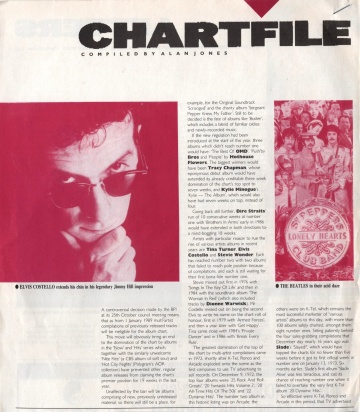Record Mirror, November 12, 1988: Difference between revisions
(start page) |
(+text part 1) |
||
| Line 9: | Line 9: | ||
---- | ---- | ||
{{Bibliography text}} | {{Bibliography text}} | ||
A controversial decision made by the BPI at its 25th October council meeting means that as from 1 January 1989 multi-artist compilations of previously released tracks will be ineligible for the album chart. | |||
This move will obviously bring an end to the domination of the chart by albums in the ''Now'' and ''Hits'' series which, together with the similarly unwelcome ''Nite Flite'' (a CBS album of soft soul) and ''Hot City Nights'' (Polygram's AOR collection) have prevented other, regular album releases from claiming the chart's premier position for 19 weeks in the last year. | |||
Unaffected by the ban will be albums comprising of new, previously unreleased material, so there will still be a place. for example, for the Original Soundtrack ''Scrooged'' and the charity album ''Sergeant Pepper Knew My Father''. Still to be decided is the fate of albums like ''Buster'', which includes a blend of familiar oldies and newly-recorded music. | |||
If the new regulation had been introduced at the start of this year, three albums which didn't reach number one would have: ''The Best Of OMD'', ''Push'' by Bros and ''People'' by Hothouse Flowers. The biggest winners would have been Tracy Chapman, whose eponymous debut album would have extended its already creditable three week domination of the chart's top spot to seven weeks, and Kylie Minogue's ''Kylie — The Album'', which would also have had seven weeks on top, instead of four. | |||
Going back still further, Dire Straits" run of 10 consecutive weeks at number one with ''Brothers In Arms'' early in 1986 would have extended in both directions to a mind-boggling 18 weeks. | |||
Artists with particular reason to rue the rise of various artists albums in recent years are Tina Turner, Elvis Costello and Stevie Wonder. Each has reached number two with two albumt that failed to reach pole position because of compilations. and each is still waiting for their first bona-fide number one. | |||
Stevie missed out first in 1976 with ''Songs In The Key Of Life'' and then in 1984 with the soundtrack album ''The Woman In Red'' (which also included tracks by Dionne Warwick). Mr Costello missed out on being the second Elvis to write his name on the chart roll of honour, first in 1979 with ''[[Armed Forces]]'', and then a year later with ''[[Get Happy!!|Get Happy]]''. Tina came close with 1984's ''Private Dancer'' and in 1986 with ''Break Every Rule''. | |||
The greatest domination of the top of the chart by multi-artist compilations came in 1972, shortly after K-Tel, Ronco and Arcade exploded onto the scene as the first companies to use TV advertising to sell records. On December 9, 1972, the top four albums were ''25 Rock And Roll Greats'', ''20 Fantastic Hits Volume 2'', ''20 All-Time Hits Of The 50s'' and ''22 Dynamic Hits''. The number two album in this historic listing was on Arcade, the others were on K-Tel, which remains the most successful marketer of "various artists" albums to this day, with more than 100 albums safely charted, amongst them eight number ones. Sitting patiently behind the four sales-grabbing compilations that December day nearly 16 years ago was Slade's ''Slayed?''. which would have topped the charts for no fewer than five weeks before it got its first official week al number one on January 13, 1973. Six months earlier, Slade's first album ''Slade Alive'' was less tenacious, and lost its chance of reaching number one when it failed to overtake the very first K-Tel album ''20 Dynamic Hits''. | |||
So effective were K-Tel, Ronco and Arcade in this period, that TV advertised | |||
{{cx}} | {{cx}} | ||
{{rttc}} | |||
{{Bibliography notes header}} | {{Bibliography notes header}} | ||
Revision as of 00:11, 17 October 2014
|


